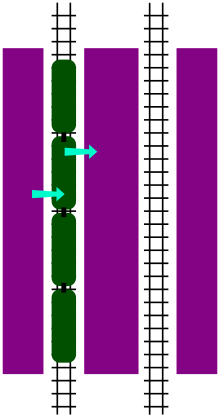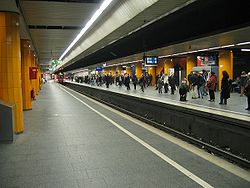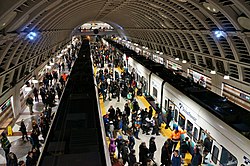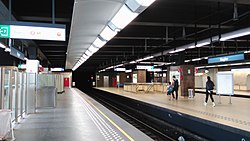
A railway platform is an area alongside a railway track providing convenient access to trains. Almost all stations have some form of platform, with larger stations having multiple platforms.

A cross-platform interchange is a type of interchange between different lines at a metro station. The term originates with the London Underground; such layouts exist in other networks but are not commonly so named. In the United States and Canada, it is often referred to as a cross-platform transfer.

The S-Bahn is a hybrid urban-suburban rail system serving a metropolitan region predominantly in German-speaking countries. Some of the larger S-Bahn systems provide service similar to rapid transit systems, while smaller ones often resemble commuter or even regional rail systems. The name S-Bahn derives from Schnellbahn, Stadtbahn or Stadtschnellbahn.
The Munich U-Bahn is an electric rail rapid transit network in Munich, Germany. The system began operation in 1971, and is operated by the municipally owned Münchner Verkehrsgesellschaft. The network is integrated into the Münchner Verkehrs- und Tarifverbund and interconnected with the Munich S-Bahn. The U-Bahn currently comprises eight lines, serving 96 stations, and encompassing 103.1 kilometres (64.1 mi) of routes.

A ghost station is a disused train station through which revenue-service passenger trains pass but at which they do not stop. The term is also sometimes used for any unused underground station or any unused station, whether or not trains pass through them. In Germany, a station that has been built in the course of constructing something else as a so-called "Bauvorleistung" is referred to as a "ghost station", despite the different purpose and origin of the terms. Some English-language publications also refer to "pre-built" stations or parts thereof that have yet to see service as "ghost stations".

Lo Wu is the northern terminus of the East Rail line of Hong Kong, located in Lo Wu within the Closed Area on Hong Kong's northern frontier. The station serves as a primary checkpoint for rail passengers between Hong Kong and mainland China and vice versa, rather than serving a specific area. It is also the northernmost railway station in Hong Kong.
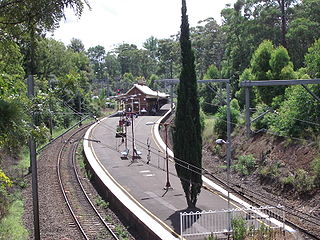
An island platform is a station layout arrangement where a single platform is positioned between two tracks within a railway station, tram stop or transitway interchange. Island platforms are popular on twin-track routes due to economic and land use reasons. They are also useful within larger stations where local and express services for the same direction of travel can be provided from opposite sides of the same platform thereby simplifying transfers between the two tracks. An alternative arrangement is to position side platforms on either side of the tracks. The historical use of island platforms depends greatly upon the location. In the United Kingdom the use of island platforms is relatively common when the railway line is in a cutting or raised on an embankment, as this makes it easier to provide access to the platform without walking across the tracks.

A side platform is a platform positioned to the side of one or more railway tracks or guideways at a railway station, tram stop, or transitway. A station having dual side platforms, one for each direction of travel, is the basic design used for double-track railway lines. Side platforms may result in a wider overall footprint for the station compared with an island platform where a single width of platform can be shared by riders using either track.

The Sentosa Express is a monorail line connecting Sentosa island to HarbourFront on the Singapore mainland. It was built at a cost of S$140 million to replace the previous Sentosa Monorail. Development began in June 2003 and construction works were completed in late 2006. The fully elevated 2.1-kilometre two-way line opened on 15 January 2007. The monorail system, privately owned by Sentosa Development Corporation and operated by Singapore Mass Rapid Transit, can move up to 4,000 passengers per hour per direction.

The Nuremberg U-Bahn is a rapid transit system run by Verkehrs-Aktiengesellschaft Nürnberg, which itself is a member of the Verkehrsverbund Großraum Nürnberg. The Nuremberg U-Bahn is Germany's newest metro system, having begun operation in 1972, although the Nuremberg-Fürth route (U1) uses part of the right of way of the Bavarian Ludwig Railway, Germany's first passenger railway opened in 1835. The current network of the U-Bahn is composed of three lines, serving 49 stations, and comprising 38.2 kilometres (23.7 mi) of operational route, making it the shortest of the four metro systems in Germany, behind Berlin, Hamburg and Munich.

München Hauptbahnhof or Munich Central Station is the main railway station in the city of Munich, Germany. It is one of the three stations with long-distance services in Munich, the others being Munich East station and Munich-Pasing station (München-Pasing). München Hauptbahnhof sees about 450,000 passengers a day, which puts it on par with other large stations in Germany, such as Hamburg Hauptbahnhof and Frankfurt (Main) Hauptbahnhof. It is classified by Deutsche Bahn as a category 1 station, one of 21 in Germany and two in Munich, the other being München Ost. The mainline station is a terminal station with 32 platforms. The subterranean S-Bahn with 2 platforms and U-Bahn stations with 6 platforms are through stations.

Munich Marienplatz is an important stop on the Munich S-Bahn and U-Bahn network, located under the square of the same name in Munich's city centre. The S-Bahn lines , , , , , and intersect with the U-Bahn lines and . The station is one of the most frequently used stations in the network, with up to 24,400 people transferring and 8,000 passengers entering or exiting each hour. In 2007, 175,400 people used the station daily on weekdays, including entries, exits and transfers.

Berlin Westkreuz is a station in the Charlottenburg district of Berlin. It is served by the S-Bahn lines S3, S41, S42, S46, S5, S7 and S9 and so represents a major interchange point on the Berlin S-Bahn network. It lies at the opposite end of the Stadtbahn to Ostkreuz and is one of the four main stations on the Ringbahn.
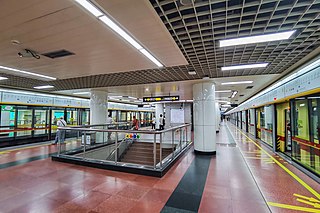
Gongyuanqian Station is an interchange station of Line 1 and Line 2 of the Guangzhou Metro. It started operation on 28 June 1999 and is located under People's Park in Yuexiu District of Guangzhou.

Luohu station is an underground terminus of Line 1 of the Shenzhen Metro in Shenzhen, Guangdong Province, China. It is located beneath the East Plaza of Shenzhen railway station in Shenzhen's Luohu District. It is the second-busiest station in the network in terms of system entries and exits, with approximately 56,400 passengers a day.

A split platform or separate platform is a station that has a platform for each track, split onto two or more levels. This configuration allows a narrower station plan horizontally, at the expense of a deeper vertical elevation, because sets of tracks and platforms are stacked above each other. Where two rail lines cross or run parallel for a time, split platforms are sometimes used in a hybrid arrangement that allows for convenient cross-platform interchange between trains running in the same general direction.

In transportation, dwell time or terminal dwell time refers to the time a vehicle such as a public transit bus or train spends at a scheduled stop without moving. Typically, this time is spent boarding or deboarding passengers, but it may also be spent waiting for traffic ahead to clear, trying to merge into parallel traffic, or idling time in order to get back on schedule. Dwell time is one common measure of efficiency in public transport, with shorter dwell times being universally desirable.

A train station, railroad station, or railroad depot and railway station is a railway facility where trains stop to load or unload passengers, freight, or both. It generally consists of at least one platform, one track, and a station building providing such ancillary services as ticket sales, waiting rooms, and baggage/freight service. Stations on a single-track line often have a passing loop to accommodate trains travelling in opposite direction.

The Munich–Rosenheim railway is a 65 kilometre-long double-track main line of the German railways. It connects Munich Hauptbahnhof with Rosenheim station, where it connects with the Rosenheim–Salzburg railway, which connects with the line to Vienna at Salzburg, and the line to Kufstein, which continues to Innsbruck and the Brenner line to Italy. The line is part of the "Main line for Europe", connecting Paris with Bratislava and Budapest and the almost identical line 17 of Trans-European Transport Networks (TEN-T). It is part of the line 1 of TEN-T. It is electrified at 15 kV, 16.7 Hz. It was opened between Munich and Rosenheim in 1871.

Yenikapı Transfer Center, referred to as Yenikapı, is an underground transportation complex in Istanbul. It is located in south-central Fatih in the neighborhood of Yenikapı, hence the name of the hub. The complex is right next to the indefinitely closed Yenikapı railway station and a short walk away from the Yenikapı Ferry Terminal and İDO ferry service. Yenikapı complex links two stations of Istanbul Metro to a railway station of the Turkish State Railways on the trans-Bosphorus Marmaray tunnel. Yenikapı is the largest rapid transit station in Turkey.
